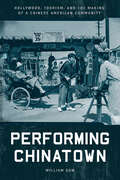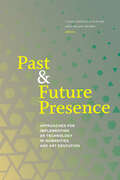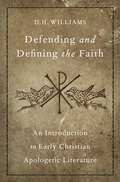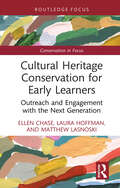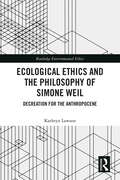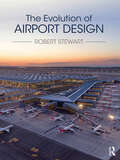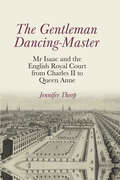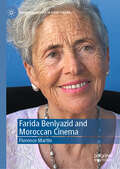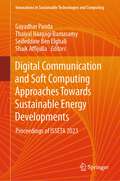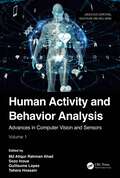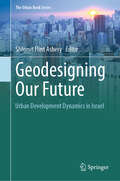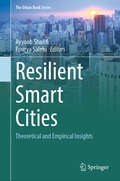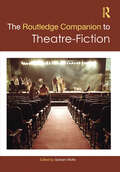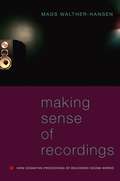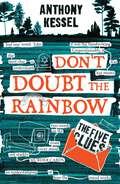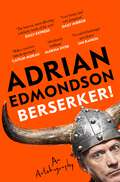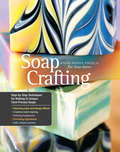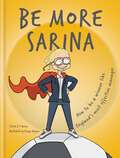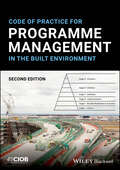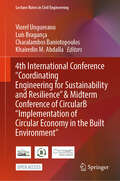- Table View
- List View
Performing Chinatown: Hollywood, Tourism, and the Making of a Chinese American Community (Asian America)
by William GowIn 1938, China City opened near downtown Los Angeles. Featuring a recreation of the House of Wang set from MGM's The Good Earth, this new Chinatown employed many of the same Chinese Americans who performed as background extras in the 1937 film. Chinatown and Hollywood represented the two primary sites where Chinese Americans performed racial difference for popular audiences during the Chinese exclusion era. In Performing Chinatown, historian William Gow argues that Chinese Americans in Los Angeles used these performances in Hollywood films and in Chinatown for tourists to shape widely held understandings of race and national belonging during this pivotal chapter in U.S. history. Performing Chinatown conceives of these racial representations as intimately connected to the restrictive immigration laws that limited Chinese entry into the U.S. beginning with the 1875 Page Act and continuing until the passage of the Immigration and Nationality Act of 1965. At the heart of this argument are the voices of everyday people including Chinese American movie extras, street performers, and merchants. Drawing on more than 40 oral history interviews as well as research in more than a dozen archival and family collections, this book retells the long-overlooked history of the ways that Los Angeles Chinatown shaped Hollywood and how Hollywood, in turn, shaped perceptions of Asian American identity.
Performing Chinatown: Hollywood, Tourism, and the Making of a Chinese American Community (Asian America)
by William GowIn 1938, China City opened near downtown Los Angeles. Featuring a recreation of the House of Wang set from MGM's The Good Earth, this new Chinatown employed many of the same Chinese Americans who performed as background extras in the 1937 film. Chinatown and Hollywood represented the two primary sites where Chinese Americans performed racial difference for popular audiences during the Chinese exclusion era. In Performing Chinatown, historian William Gow argues that Chinese Americans in Los Angeles used these performances in Hollywood films and in Chinatown for tourists to shape widely held understandings of race and national belonging during this pivotal chapter in U.S. history. Performing Chinatown conceives of these racial representations as intimately connected to the restrictive immigration laws that limited Chinese entry into the U.S. beginning with the 1875 Page Act and continuing until the passage of the Immigration and Nationality Act of 1965. At the heart of this argument are the voices of everyday people including Chinese American movie extras, street performers, and merchants. Drawing on more than 40 oral history interviews as well as research in more than a dozen archival and family collections, this book retells the long-overlooked history of the ways that Los Angeles Chinatown shaped Hollywood and how Hollywood, in turn, shaped perceptions of Asian American identity.
Past and Future Presence: Approaches for Implementing XR Technology in Humanities and Art Education
by Lissa Crofton-Sleigh Brian BeamsWhile uses and studies of XR technology within STEM-based education have been plentiful in recent years, there has been lesser or even, at times, a lack of coverage for this novel learning tool in the arts and humanities.Past and Future Presence aims to bridge some of that gap by presenting research-based theory and case studies of successful application and implementation of XR technology into postsecondary educational settings, ranging in topics from ancient to modern languages, classical and contemporary art, and reenvisioned historical scenes and events presented in ways never seen before. The studies also contemplate how this novel medium can enhance and supplement learning in classrooms and other formal or informal learning environments. The volume as a whole is intended to demonstrate to educators, scholars, and researchers in higher education the potential value of integrating XR technology into their classrooms and to provide a strong argument for college and university administrators to invest in training and development of new research and content for classrooms inside and outside of STEM. The authors of these chapters come from a diverse range of backgrounds at different stages of their careers, providing a broad crosssection of scholastic work within the humanities and arts. Each chapter offers a different angle or approach to incorporating XR technology into teaching or research within different subject areas. As the volume suggests, this technology also places additional emphasis on the humanity within the humanities, by focusing on increasing connection between users and different cultures, time periods, and perspectives.
Defending and Defining the Faith: An Introduction to Early Christian Apologetic Literature
by D.H. WilliamsIn Early Christian Apologetics, D.H. Williams offers a comprehensive presentation of Christian apologetic literature from the second to the fifth century, considering each writer within the intellectual context of the day. Williams argues that most apologies were not directed at a pagan readership. In most cases, he says, ancient apologetics had a double object: to instruct the Christian and to persuade weak Christians or non-Christians who were sympathetic to Christian claims. Traditionally, scholars of apologetics have focused on the context of persecution in the pre-Constantinian period. By following the links in the intellectual trajectory up though the early fifth century, Williams prompts deeper reflection on the process of Christian self-definition in late antiquity. Taken cumulatively, he finds, apologetic literature was in fact integral to the formation of the Christian identity in the Roman world.
Cultural Heritage Conservation for Early Learners: Outreach and Engagement with the Next Generation (Conservation in Focus)
by Ellen Chase Laura Hoffman Matthew LasnoskiCultural Heritage Conservation for Early Learners explores how to introduce young audiences to art conservation. Conservators and educators from around the world share their approach to creating engaging, hands-on programs for children aged three to eight and their caregivers.Drawing on their experiences as conservators and educators, the authors provide an in-depth look at the Smithsonian Institution’s popular “Art & Me” family workshops. Readers will gain practical insights into the workshop design, which draws upon years of program evaluation and discover how these workshops foster an understanding of cultural preservation; familiarize attendees with museum spaces; and encourage a sense of responsibility for preserving history and culture. The book also explores case studies beyond the United States, showcasing diverse approaches to early learner engagement in cultural heritage conservation. These real-world examples, encompassing various settings and collaborations, delve into the adaptation of virtual and online resources in response to contemporary challenges.Cultural Heritage Conservation for Early Learners is an indispensable guide for emerging and established educators, conservators, and museum professionals who wish to integrate art conservation and cultural heritage preservation into early learning. It is a valuable resource for anyone interested in innovative, arts integration teaching methods that enhance critical thinking and foster a deeper appreciation of cultural heritage.
Cultural Heritage Conservation for Early Learners: Outreach and Engagement with the Next Generation (Conservation in Focus)
by Ellen Chase Laura Hoffman Matthew LasnoskiCultural Heritage Conservation for Early Learners explores how to introduce young audiences to art conservation. Conservators and educators from around the world share their approach to creating engaging, hands-on programs for children aged three to eight and their caregivers.Drawing on their experiences as conservators and educators, the authors provide an in-depth look at the Smithsonian Institution’s popular “Art & Me” family workshops. Readers will gain practical insights into the workshop design, which draws upon years of program evaluation and discover how these workshops foster an understanding of cultural preservation; familiarize attendees with museum spaces; and encourage a sense of responsibility for preserving history and culture. The book also explores case studies beyond the United States, showcasing diverse approaches to early learner engagement in cultural heritage conservation. These real-world examples, encompassing various settings and collaborations, delve into the adaptation of virtual and online resources in response to contemporary challenges.Cultural Heritage Conservation for Early Learners is an indispensable guide for emerging and established educators, conservators, and museum professionals who wish to integrate art conservation and cultural heritage preservation into early learning. It is a valuable resource for anyone interested in innovative, arts integration teaching methods that enhance critical thinking and foster a deeper appreciation of cultural heritage.
Ecological Ethics and the Philosophy of Simone Weil: Decreation for the Anthropocene (Routledge Environmental Ethics)
by Kathryn LawsonThis book places the philosophy of Simone Weil into conversation with contemporary environmental concerns in the Anthropocene.The book offers a systematic interpretation of Simone Weil, making her ethical philosophy more accessible to non-Weil scholars. Weil’s work has been influential in many fields, including politically and theologically-based critiques of social inequalities and suffering, but rarely linked to ecology. Kathryn Lawson argues that Weil’s work can be understood as offering a coherent approach with potentially widespread appeal applicable to our ethical relations to much more than just other human beings. She suggests that the process of "decreation" in Weil is an expansion of the self which might also come to include the surrounding earth and a vast assemblage of others. This allows readers to consider what it means to be human in this time and place, and to contemplate our ethical responsibilities both to other humans and also to the more-than-human world. Ultimately, the book uses Weil’s thought to decanter the human being by cultivating human actions towards an ecological ethics.This book will be useful for Simone Weil scholars and academics, as well as students and researchers interested in environmental ethics in departments of comparative literature, theory and criticism, philosophy, and environmental studies.
Ecological Ethics and the Philosophy of Simone Weil: Decreation for the Anthropocene (Routledge Environmental Ethics)
by Kathryn LawsonThis book places the philosophy of Simone Weil into conversation with contemporary environmental concerns in the Anthropocene.The book offers a systematic interpretation of Simone Weil, making her ethical philosophy more accessible to non-Weil scholars. Weil’s work has been influential in many fields, including politically and theologically-based critiques of social inequalities and suffering, but rarely linked to ecology. Kathryn Lawson argues that Weil’s work can be understood as offering a coherent approach with potentially widespread appeal applicable to our ethical relations to much more than just other human beings. She suggests that the process of "decreation" in Weil is an expansion of the self which might also come to include the surrounding earth and a vast assemblage of others. This allows readers to consider what it means to be human in this time and place, and to contemplate our ethical responsibilities both to other humans and also to the more-than-human world. Ultimately, the book uses Weil’s thought to decanter the human being by cultivating human actions towards an ecological ethics.This book will be useful for Simone Weil scholars and academics, as well as students and researchers interested in environmental ethics in departments of comparative literature, theory and criticism, philosophy, and environmental studies.
The Evolution of Airport Design
by Robert StewartThis is the first book to comprehensively cover the evolution of airport design, from the start of commercial aviation in 1919 to the present day. Many books have been written about airport design at a particular moment in history, but none have rigorously considered why, where, when and how the ideas we now take for granted originated.This book traces the history of airport design considering the philosophies adopted by designers, the functional layouts they have developed and the resultant form of the airport through a series of 40 case studies divided into 7 eras of approximately 20 years each. The themes include: The philosophies underpinning airport design The evolution of design responses How airports have avoided obsolescence Identification of the key turning points The evolution of master plans and terminal concepts in response to increasing traffic volumes The future of airports in terms of environmental sustainability and the Covid-19 hiatus The case studies are international, covering the USA, Germany, the UK, France, the Netherlands, Singapore, Saudi Arabia, Japan, Hong Kong, Malaysia, South Korea, Thailand, Spain, United Arab Emirates, China, Turkey, Mexico, Australia and Poland. They are illustrated with full colour, many of which have not been published before and form part of an incredible graphic package. This book is essential reading for architects, engineers, planners and environmentalists alike.
The Evolution of Airport Design
by Robert StewartThis is the first book to comprehensively cover the evolution of airport design, from the start of commercial aviation in 1919 to the present day. Many books have been written about airport design at a particular moment in history, but none have rigorously considered why, where, when and how the ideas we now take for granted originated.This book traces the history of airport design considering the philosophies adopted by designers, the functional layouts they have developed and the resultant form of the airport through a series of 40 case studies divided into 7 eras of approximately 20 years each. The themes include: The philosophies underpinning airport design The evolution of design responses How airports have avoided obsolescence Identification of the key turning points The evolution of master plans and terminal concepts in response to increasing traffic volumes The future of airports in terms of environmental sustainability and the Covid-19 hiatus The case studies are international, covering the USA, Germany, the UK, France, the Netherlands, Singapore, Saudi Arabia, Japan, Hong Kong, Malaysia, South Korea, Thailand, Spain, United Arab Emirates, China, Turkey, Mexico, Australia and Poland. They are illustrated with full colour, many of which have not been published before and form part of an incredible graphic package. This book is essential reading for architects, engineers, planners and environmentalists alike.
The Gothic Peckinpah
by Tony WilliamsThis book argues for the importance of Gothic in understanding one of the key elements within the films of Sam Peckinpah (1925-1984). Although occasionally noted in the past, the Gothic has been generally overlooked when most critics consider the work of Sam Peckinpah with the exception of the Freudian based Crucified Heroes (1979) by Terence Butler. This work not only examines the films made after that date, especially the often dismissed The Osterman Weekend (1983) and the two music videos he made for Julian Lennon, but also places the director within the context of the developing work on Gothic that has since appeared. Peckinpah has been identified as the director of one undisputed masterpiece, The Wild Bunch (1969). By focussing on the key role Gothic plays in most of the director’s work, this book offers a way to see Peckinpah beyond The Wild Bunch and the Western, viewing him as a director who had the potential of evolving further, had circumstances permitted, to continue his critique of American life within the developing lens of the Gothic.
The Gentleman Dancing-Master: Mr Isaac and the English Royal Court from Charles II to Queen Anne (Clemson University Press: Studies in British Musical Cultures)
by Jennifer ThorpThe Gentleman Dancing-Master: Mr Isaac and the English Royal Court from Charles II to Queen Anne is a study of the life of the most significant dancing-master at the late-Stuart court in London. It discusses his use of dance music and brings together, for the first time, reprints of the notations of all his twenty-three surviving dances created for performance at court in the presence of the monarch, including several created to celebrate the birthdays of Queen Anne or named after important courtiers or political events. This study highlights the significance of dance as a central part of court culture, and also the wider context of the London book trade within which Isaac’s notators turned his dances into a publishable form ultimately taken over by John Walsh’s music publishing firm. Using extensive archival and printed sources from his day, the book follows Isaac’s career as a dancer, teacher, and choreographer of sophisticated duets in the fashionable French style, some of which were also performed in the theatre. Isaac, however, was no slavish follower of French fashion, and by careful consideration of the extant dances from the point of view of a dancer, this study also seeks to throw light on Isaac’s often individualistic approach to choreography.
Farida Benlyazid and Moroccan Cinema (Palgrave Studies in Arab Cinema)
by Florence MartinThis book project unfolds and analyzes the work of Moroccan director, producer, and scriptwriter Farida Benlyazid, whose career extends from the beginning of cinema in independent Morocco to the present. This study of her work and career provides a unique perspective on an under-represented cinema, the gender politics of cinema in Morocco, and the contribution of Arab women directors to global cinema and to a gendered understanding of Muslim ethics and aesthetics in film. A pioneer in Moroccan cinema, Farida Benlyazid has been successful at negotiating the sometimes abrupt turns of Morocco’s rocky 20th century history: from Morocco under French occupation to the advent of Moroccan independence in 1956; the end of the international status of Tangier, her native city, in 1959; the “years of lead” under the reign of Hassan II; and finally Mohamed VI’s current reign since 1999. As a result, she has a long view of Morocco’s politics of self-representation as well as of the representation of Moroccan women on screen
Digital Communication and Soft Computing Approaches Towards Sustainable Energy Developments: Proceedings of ISSETA 2023 (Innovations in Sustainable Technologies and Computing)
by Gayadhar Panda Thaiyal Naayagi Ramasamy Seifeddine Ben Elghali Shaik AffijullaThis book is a second volume and contains selected papers presented at Second International Symposium on Sustainable Energy and Technological Advancements (ISSETA 2023), organized by the Department of Electrical Engineering, NIT Meghalaya, Shillong, India, during 24 – 25 February 2023. The topics covered in the book are the cutting-edge research involved in sustainable energy technologies, smart buildingtechnology, integration and application of multiple energy sources; advanced power converter topologies and their modulation techniques; and information and communication technologies for smart microgrids.
Human Activity and Behavior Analysis: Advances in Computer Vision and Sensors: Volume 1 (Ubiquitous Computing, Healthcare and Well-being)
by Md Atiqur Rahman AhadHuman Activity and Behavior Analysis relates to the field of vision and sensor-based human action or activity and behavior analysis and recognition. The book includes a series of methodologies, surveys, relevant datasets, challenging applications, ideas, and future prospects.The book discusses topics such as action recognition, action understanding, gait analysis, gesture recognition, behavior analysis, emotion and affective computing, and related areas. This volume focuses on relevant activities in three main subject areas: Healthcare and Emotion, Mental Health, and Nurse Care Records.The editors are experts in these arenas and the contributing authors are drawn from high-impact research groups around the world. This book will be of great interest to academics, students, and professionals working and researching in the field of human activity and behavior analysis.
Geodesigning Our Future: Urban Development Dynamics in Israel (The Urban Book Series)
by Shlomit Flint AsheryThis book examines how map-based collaboration software can facilitate negotiations in areas undergoing contentious pressures for significant change. Based on case studies from Israel, it aims to introduce a useful model of planning implementation as an outcome of complex interaction to reduce the gap between planning and urban reality. It puts an analytical realist foundation for a productive discussion of the role of future planning and bares meaningful scientific contributions to the general frame of the negotiating process and implementation, which still needs further research and elaboration.Geodesign, a cutting-edge planning approach that is rooted in the history of planning practice, has become one of the most popular approaches for sustainable planning and design activities after 2000s. Planners tend to think of design at a site scale, but geodesign covers a variety of scales, bridging the gap between the regional and the local contexts.This is important because to be practically effective and politically prudent, "smart growth" plans need to make sense across a spectrum of scales and disciplines. This ranges from design, urban design, community planning, town and city planning, and regional planning, up to planning for mega-regions.
Resilient Smart Cities: Theoretical and Empirical Insights (The Urban Book Series)
by Ayyoob Sharifi Pourya SalehiThis book provides a thorough guide to building resilient cities, through the use of smart solutions enabled by information and communication technologies. It introduces innovative approaches for integrating smart solutions into urban resilience planning and offers numerous global case studies to illustrate the benefits of the theories discussed. Against a background of increased natural disasters, pandemics, and climate change, this book answers research questions such as: • Do smart city projects contribute to urban climate resilience?• What are the indicators of smart city resilience?• What procedures should be taken to improve efficacy of smart city solutions?• What are the opportunities and challenges for promoting smart city resilience and for integrating resilience thinking into smart city planning? Including contributions from international experts, explanatory illustrations, and data-driven tables, this book is of interest to researchers, policymakers, and graduate students focused on developing more sustainable, smart, and resilient cities.
The Routledge Companion to Theatre-Fiction (Routledge Literature Handbooks)
by Graham WolfeNovelists have long been attracted to theatre. Some have pursued success on the stage, but many have sought to combine these worlds, entering theatre through their fiction, setting stages on their novels’ pages, and casting actors, directors, and playwrights as their protagonists. The Routledge Companion to Theatre-Fiction has convened an international community of scholars to explore the remarkable array of novelists from many eras and parts of the world who have created fiction from the stuff of theatre, asking what happens to theatre on the pages of novels, and what happens to novels when they collaborate with theatre. From J. W. Goethe to Louisa May Alcott, Mikhail Bulgakov, Virginia Woolf, and Margaret Atwood, some of history’s most influential novelists have written theatre-fiction, and this Companion discusses many of these figures from new angles. But it also spotlights writers who have received less critical attention, such as Dorothy Leighton, Agustín de Rojas Villandrando, Ronald Firbank, Syed Mustafa Siraj, Li Yu, and Vicente Blasco Ibañez, bringing their work into conversation with a vital field. A valuable resource for students, scholars, and admirers of both theatre and novels, The Routledge Companion to Theatre-Fiction offers a wealth of new perspectives on topics of increasing critical concern, including intermediality, theatricality, antitheatricality, mimesis, diegesis, and performativity.
Making Sense of Recordings: How Cognitive Processing of Recorded Sound Works
by Mads Walther-HansenBuilding on ideas from cognitive metaphor theory, Making Sense of Recordings offers a new perspective on record production, music perception, and the aesthetics of recorded sound. It shows how the language about sound is intimately connected to sense-making - both as a reflection of our internal cognitive capacities and as a component of our extended cognitive system. In doing so, the book provides the foundation for a broader understanding of the history of listening, discourses of sound quality, and artistic practices in the age of recorded music. The book will be of interest to anyone who asks how recorded music sounds and why it sounds as it does, and it will be a valuable resource for musicology students and researchers interested in the analysis of sound and the history of listening and record production. Additionally, sound engineers and laptop musicians will benefit from the book's exploration of the connection between embodied experiences and our cognitively processed experiences of recorded sound. The tools provided will be useful to these and other musicians who wish to intuitively interact with recorded or synthesized sound in a manner that more closely resembles the way they think and that makes sense of what they do.
The Five Clues (Don't Doubt the Rainbow)
by Anthony KesselThe first book in the series, The Five Clues, is a real-time murder-mystery thriller and family drama, combining an exciting race against time with a heart-rending story about a teenager learning to live with the loss of a beloved parent. Walking back from her mother's grave, 13-year-old schoolgirl Edie Marble finds a note in a pocket of the sheepskin coat that she hasn't worn since the day, a year earlier, when she received the awful news of her mother's death. The note is from her mother, who had been looking into a corporate human rights violation and had become fearful for her life after receiving death threats. She trusts only Edie because of their special bond and Edie's intelligence and has laid a trail of clues for Edie to find that will help her to shed light on the violation and uncover the mystery around her death. Through her wit and determination, Edie steadily gathers evidence and negotiates the dramatic twists and turns of the story by collaborating with her friends and family to gradually unearth a sinister attempt by a pharmaceutical company to conceal their illegal development of a lethal virus. As Edie's investigations progress she is introduced, in parallel, to the Three Principles, which help her conquer various psychological stresses and support her in coming to terms with her grief. Reading age 11+.
Berserker!: The deeply moving and brilliantly funny memoir from one of Britain's most beloved comedians
by Adrian EdmondsonThe instant Sunday Times bestseller and Financial Times Best Audio of 2023From brutal schooldays to 80s anarchy, through The Young Ones, Bottom and beyond, Berserker! is the one-of-a-kind, fascinating memoir from an icon of British comedy, Adrian Edmondson.Ade Edmondson revolutionized the comedy circuit in the 1980s and, alongside Rik Mayall, brought anarchy to stage and screen. How did a child brought up in a strict Methodist household – and who spent his formative years incarcerated in repressive boarding schools – end up joining the revolution?With wisdom, nostalgia and uniquely observed humour, Ade traces his journey through life and comedy: starting out on the alternative scene, getting arrested in Soho, creating outrageously violent characters and learning more about his curious (possibly Scandinavian) heritage. With star-studded anecdotes and set to a soundtrack of pop hits which transport the reader through time, it’s a memoir like no other.Nominated for Radio Times Moment of the Year for sharing his memories of Rik Mayall on Desert Island Discs.'The Berserker from The Young Ones and Bottom tells his story with self-effacing charm and no end of backstage anecdotes' - Ian Rankin'Amazing' - Richard Osman'Gloriously candid and wise all at once' - Sara Pascoe'It is incredibly funny, but it is also a lot, lot more than that' - Miles Jupp‘More fun than reading Hegel, and also more enlightening’ - Louis de Bernières
Soap Crafting: Step-by-Step Techniques for Making 31 Unique Cold-Process Soaps
by Anne-Marie FaiolaMake your own custom-tailored and perfectly formed cold-process soaps! Learn how to use milk jugs and yogurt containers for molds, and how coffee, avocado, and even beer can add unique dimensions to your creations. This encouraging introduction to the art of soapmaking makes it simple to master the techniques you need to safely and easily produce your own enticingly fragrant soaps.
Be More Sarina: Celebrate the Manager of England’s World Cup Finalists
by S. Ford T. DaviesIs there anyone with a track record like Sarina Weigman? Undefeated at any finals she is the epitome of success, so shouldn't you... be more Sarina?Here are 80 scenarios in which Sarina would operate with flawless efficiency, such as:Sarina would never wear a half-and-half scarf.Sarina could design a VAR system that everyone was happy with.Sarina could make cyclists and taxi drivers get along.Sarina always believed it would take women to bring it home.Perfect for the footy fan in your life, and publishing just ahead of the 2023 Women's World Cup, Be More Sarina is the fun way to celebrate England's most successful football manager.
Code of Practice for Programme Management in the Built Environment
by CIOB (The Chartered Institute of Building)CODE OF PRACTICE FOR PROGRAMME MANAGEMENT IN THE BUILT ENVIRONMENT Manage a construction programme from start to finish with this up-to-date guide The maturation and proliferation of project management principles has been one of the most important stories in recent business history. So widely has project management spread throughout the corporate world that it has now given way to a similar discipline, programme management, designed to align, coordinate and manage a number of related projects as a whole. In the construction industry particularly, programme management can deliver benefits that would not have been possible to realise had individual projects been managed independently. Produced by the Chartered Institute of Building (CIOB), the revised Code of Practice for Programme Management in the Built Environment provides a comprehensive overview of the tools required to deliver such benefits, and how they are applied in construction programmes. A natural complement to the CIOB’s popular Code of Practice for Project Management for the Built Environment, it is now fully updated to reflect new insights and best practices. Readers of the second edition of Code of Practice for Programme Management in the Built Environment will find: Theoretical and practical insights derived from research and experience Coverage of setting up programmes successfully so that teams feel confident to deliver the final outcome Guidelines for implementing programme management for the built environment Code of Practice for Programme Management in the Built Environment is ideal for programme management and project management professionals involved in this industry and in particular, contractors and client organisations, as well as for advanced undergraduate and postgraduate students in construction project management and other related disciplines. The Chartered Institute of Building is the world’s largest professional body for construction management and leadership. It has a Royal Charter to promote the science and practice of building and construction for the benefit of society. Members across the world work in the development, conservation, and improvement of the built environment.
4th International Conference "Coordinating Engineering for Sustainability and Resilience" & Midterm Conference of CircularB “Implementation of Circular Economy in the Built Environment” (Lecture Notes in Civil Engineering #489)
by Viorel Ungureanu Luís Bragança Charalambos Baniotopoulos Khairedin M. AbdallaThis open access book gathers the proceedings of the 4th International Conference “Coordinating Engineering for Sustainability and Resilience” (CESARE) & Midterm Conference of CircularB “Implementation of Circular Economy in the Built Environment”, held in Timișoara, Romania, on May 29-31, 2024, as part of the COST Action CA21103. The volume represents the state of the art of sustainability and resilience in modern and future built environment, constructions, and infrastructure, and includes topics such as structural materials and robustness, fire engineering, risk assessment, impact of climate change on the built environment, sustainable resilience of systems in the built environment, smart cities, circular economy, design strategies for product design, integration of renewable energy at building and small urban area scales, restoration & rehabilitation of historical buildings, sustainable infrastructures, wind energy structures, façade engineering, green buildings, and waste management.
